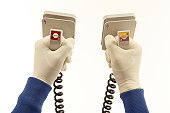Defibrillation

What Is Defibrillation?
It is a specific medical treatment in which a defibrillator (An apparatus used to control heart fibrillation by application of an electric current to the chest wall or heart) delivers electrical energy to an afflicted heart. Healthcare professionals determine the level of electrical charge (joules) to apply, based on their experience and tested practices under medical consultation. The electrical charge is applied to the patient’s chest through pads or paddles connected to the defibrillator.
The electrical shock to the heart depolarizes a critical amount of the heart’s muscle, stops the arrhythmia (beating), and lets the regular sinus rhythm restart through the body’s natural pacemaker chemicals, in the sinoatrial node of the heart.
This device is used for life-threatening conditions such as cardiac arrhythmias or a ventricular fibrillation. A cardiac arrhythmia occurs when there is unusual electrical activity inside the heart. The heart rate can be too low, too high or irregular.
A ventricular fibrillation heart condition happens when there is an uneven contraction within the cardiac muscles in the chambers inside the heart. This causes the muscles to quiver instead of contracting appropriately. The quiver may be described as a writhing motion like what you might see in a container filled with worms.
Basically,average individual can not detect a quivering pulse by touching their normal pulse points on the inside of the wrist or on the side of the neck. A certified ECG technician with ECG/EKG training can detect the unusual pulse. A healthcare professional like an ECG technician often uses a manual defibrillator along with an electrocardiogram (ECG) monitor to help diagnose the heart condition. A lot of defibrillators have built-in ECG devices.
Defibrillators are mainly found in ambulances, medical clinics and hospitals because they require specific medical training. In most hospitals, ECG/EKG training normally includes ECG/EKG classes on how to recognize life-threatening cardiac arrhythmias and ventricular fibrillation heart conditions. This knowledge is critical to deliver the proper defibrillation treatment.
ECG technicians can be found working in a hospital’s cardiology department, nursing homes, or in a hospital emergency area. They also might work directly with patients after heart surgery. Nursing assistants often take ECG/EKG classes so they can work in a telemetry or emergency rooms.
Healthcare professionals need to have an ECG/EKG certification before they can provide defibrillation to patients.
Their training usually includes how to:
- Prepare the patient
- Operate an ECG device
- Position the electrical leads
- Analyze ECG tracings
Thanks to advances in technology, defibrillation can be given through several types of devices.
These devices include:
- Manual external defibrillators
- Manual internal defibrillators
- Semi-automated external defibrillators
- Automated external defibrillator (AED)
- Implantable cardioverter-defibrillator (ICD)
- Wearable cardiac defibrillator
These devices are now considered to be standard equipment on ambulances around the world. In addition, nowadays it is accessible in all crowded areas including sport stadiums, large offices, fitness clubs and airports.

Comments
Post a Comment